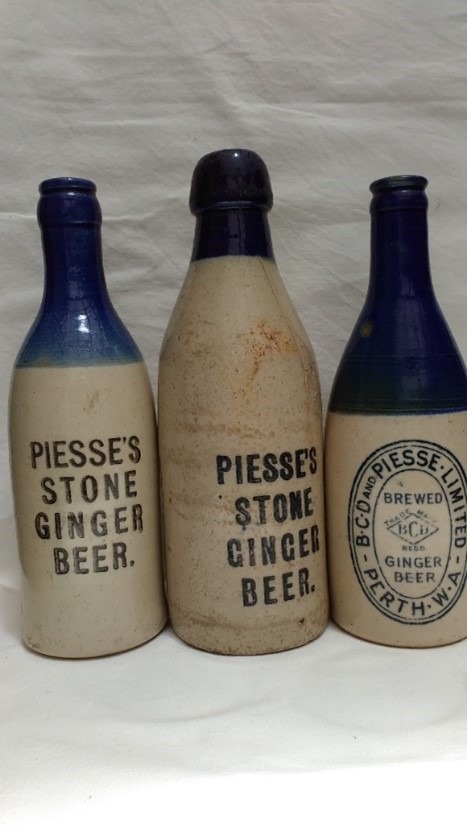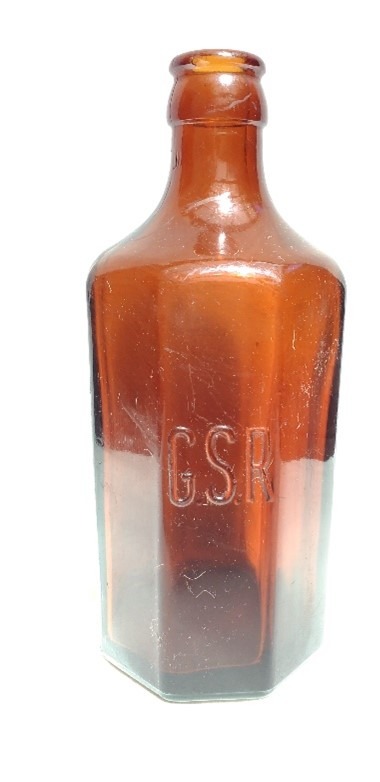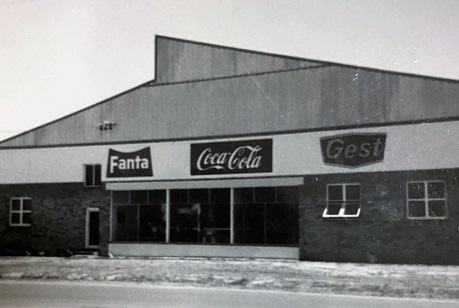Piesse Aerated Water
Piesse Cordial Factory
Piesse Aerated Water
GSR Aerated Water
Frederick Henry Piesse and his brother, Charles Austin Piesse started an Aerated Waters factory at Katanning in the 1890’s.

The first known bottle featuring the initials GSR by the Piesse brothers is a hybrid Codd bottle with the acid etched wording – F&C Piesse Katanning, GSR. There are only believed to be two surviving examples of this bottle. Piesse bottles did not use these initials again on their wares till much later in the mid 1930’s when the company changed to GSR. (The name GSR was the initials of “Great Southern Railway” and was used because of the factory’s proximity to the railway line.)

Piesse joined with BCD of Perth in 1919 and Jack Coventry, who had been a member of Piesse staff for 18 years, bought the Piesse business in partnership with Dr. Hanrahan of Albany and so began the GSR Aerated Water Co.
In Albany, the original factory belonged to Lambert’s, followed by Genoni, then Francis & Meyer. Arthur Meyer was a brewer and cool drink manufacturer and, in 1936, began his association with the GSR Company at Albany
The Narrogin connection began in 1937 in Nicholas Bushalla’s old building. Bushalla died in 1925 and his wife Elizabeth continued in the trade for some time. Then George Grainger carried on for GSR till bought out by Coca Cola in the 60’s. Elizabeth Bushalla died in 1943 and George Grainger passed away at Narrogin in 1971.

Busselton began in 1940 and GSR produced many varieties of drinks including Lemonade, Ginger Ale, Lime & Soda, Ginger Beer, Strawberry Cream & Soda, Splash Cola, etc.
As the population grew the factories at Katanning, Narrogin, Busselton and Albany were kept busy distributing their wares throughout the Great Southern till the 1960’s when Coca Cola began its ownership of many small operators throughout the state. GSR was acquired by Coca Cola in 1966 and it shut down the old factory in Katanning and moved to new premises in Daping Street (now used by a transport company).

Coca Cola bottling factory in Daping Street c1966
It then used the Albany and Busselton factories as warehouses for its Gest and other lines and eventually shut down the plant at Katanning in the 1980’s. (The name Gest was created after Coca Cola took over Golden West Aerated Waters in Perth. After many years the name “Gest” was dropped in favour of “Kirk’s”.)
In Albany, during the 1950’s, about eight men worked at the factory and the labels were placed on the bottles by hand. Bert Howe managed the factory until Coca Cola bought the business from the Meyer family. Meanwhile, in Busselton the original factory was owned by Arthur Wilson. He sold out to Hanrahan & Coventry and they offered the manager’s position to Sid Heath. He trained at Katanning for a couple of weeks and began at Busselton about August 1948.
The factory was on the corner of Kent and West streets. It was an old corrugated iron building with an addition to house the cases of drinks and bottles. The West St. end of the building housed the bottling machine, a foot levered Crown sealer, syrup table and cases of washed bottles. Down the back of the block near the fence, broken bottles were dumped. The glass was then sent to the WA Glass Manufacturers to be recycled. Outside the building a large tank stood on a high stand with a ladder up the side. Here all the water used in the drinks was gravity fed through special stone filters and bags.
Bottles were first soaked in a large tub of hot water to remove labels then put upside down on a rotating brush with water flowing from the centre. There were about 50 brushes on a revolving table and once they had done a cycle the bottles were manually sighted to make sure they were clean. Any doubtful ones had to be cleaned by hand before returning to the rotating brush.
Sugar was put in to dissolve in large vats, strained then preservative added. The measure of syrup was put into the bottles passed by hand to the filling machine which added mixed water and gas. Filled bottles were taken from the machine by hand and placed onto the sealer where crown seals were put on and this machine was worked by a foot pedal. Bottles were then sighted for floaters (foreign matter). The Heath family got the ones which had floaters in them as it was usually only dark pulp from the flavouring.
After they were filled and sighted they were labelled by hand and then placed in crates of five dozen for delivery. After WW2 there was a shortage of bottles etc. and the factory could only produce cases of five dozen bottles of one flavour at a time. Customers always wanted more than could be supplied. Sid Heath employed two permanent staff and casual workers as required. As the cases were so heavy two men had to deliver the goods to the stores.
When GSR wanted to build a new factory land was purchased on the corner of Harris Road & Brown Street in Busselton during 1956 and Jack Coventry’s brother, Bob, came over from Katanning and built a new brick building. Sid Heath gave up managing the factory in 1963 and Sid Davies took over but Heath stayed on for a while as an employee. After Coca Cola bought the GSR company in 1968 it was used as a storage facility. Sid Davies was storeman till 1970 when it closed and, by 2006, the building was demolished and is now up for redevelopment.
From The Colonial Bottle & Collectors Club of WA Inc.
Written by Vivienne Sinclair
Reproduced with permission.
Return to HOME Page
Visit our FACEBOOK Page
Piesse aerated water. Piesse aerated water. Piesse aerated water. Piesse aerated water. Piesse aerated water. Piesse aerated water. Piesse aerated water.
